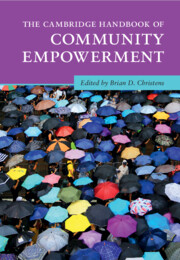Book contents
- The Cambridge Handbook of Community Empowerment
- Cambridge Handbooks in Psychology
- The Cambridge Handbook of Community Empowerment
- Copyright page
- Contents
- Figures
- Tables
- Contributors
- Building Community Power
- Part I Organizing and Activism
- Part II Participatory Governance
- Part III Civil Society and Coalitions
- Part IV Enterprise
- Part V Participatory and Community Arts
- Part VI Education and Engaged Research
- Contributor Details
- Index
- References
Building Community Power
An Introduction
Published online by Cambridge University Press: 18 April 2024
- The Cambridge Handbook of Community Empowerment
- Cambridge Handbooks in Psychology
- The Cambridge Handbook of Community Empowerment
- Copyright page
- Contents
- Figures
- Tables
- Contributors
- Building Community Power
- Part I Organizing and Activism
- Part II Participatory Governance
- Part III Civil Society and Coalitions
- Part IV Enterprise
- Part V Participatory and Community Arts
- Part VI Education and Engaged Research
- Contributor Details
- Index
- References
Summary
This book is about ways that people can build and exercise power to influence the systems that affect their lives. Each chapter provides a deep examination of a different approach. This introductory chapter begins with a discussion on definitions of empowerment and then lays out five perspectives that orient the contributions in the book. It then describes the structure and contents of the book, which are organized into six parts: (1) organizing and activism, (2) participatory governance, (3) civil society and coalitions, (4) enterprise, (5) participatory and community arts, and (6) education and engaged research. This is followed by reflections on the book’s scope and potential uses by different audiences.
Keywords
- Type
- Chapter
- Information
- The Cambridge Handbook of Community Empowerment , pp. 1 - 32Publisher: Cambridge University PressPrint publication year: 2024

